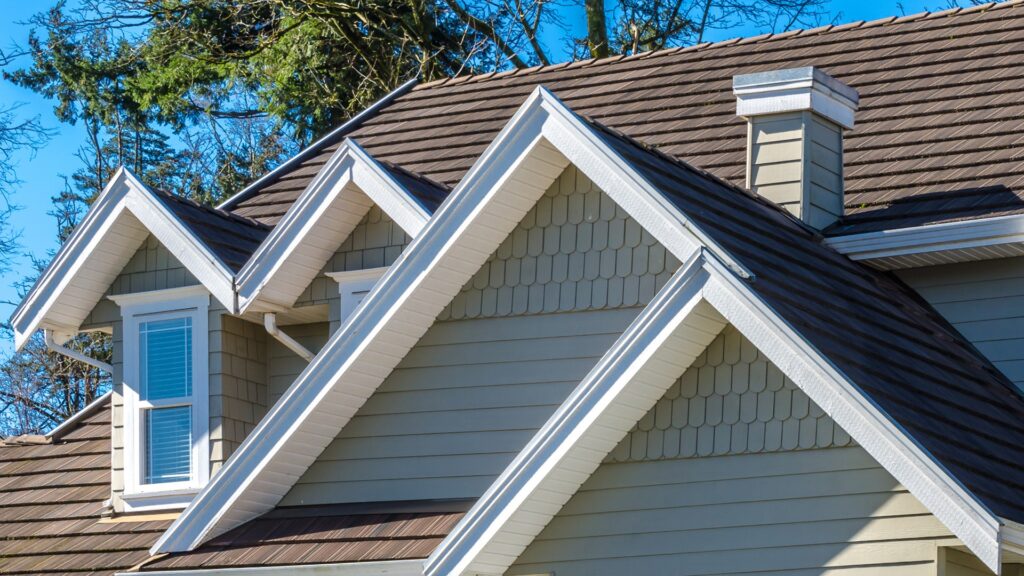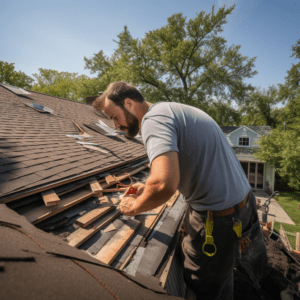Roofing, an essential aspect of architectural design, has evolved over the years to encompass innovative materials, unique designs, and creative solutions. This article explores a range of unconventional techniques and cutting-edge trends in roofing. By examining artistic styles and imaginative concepts, readers will gain insight into the possibilities that exist beyond traditional roofing methods. Through scholarly analysis and comprehensive research, this article aims to inform and inspire architects, designers, and homeowners alike.
Key Takeaways
- Creative roofing concepts incorporate unique designs and materials that add aesthetic appeal and architectural interest.
- Innovative materials options, such as solar photovoltaic panels and green roofs, enhance performance and longevity while addressing sustainability goals.
- Cost-effective roofing solutions, such as reflective coatings and lightweight materials, can reduce energy consumption and lower cooling costs.
- Regular maintenance and prompt repairs are crucial in prolonging the lifespan of a roof and avoiding costly replacements.
Innovative Roofing Materials
Innovative roofing materials have emerged in recent years, offering new possibilities for sustainable and efficient building design. These materials are designed to address the challenges of traditional roofing systems such as high energy consumption, limited lifespan, and environmental impact.
One such material is solar roof tiles. These tiles are made from photovoltaic cells that convert sunlight into electricity. They can be seamlessly integrated into the roof surface, providing a clean and aesthetically pleasing alternative to traditional solar panels. Solar roof tiles not only generate renewable energy but also offer insulation benefits by reducing heat transfer through the roof.
Another innovative material is green roofs. Green roofs consist of a layer of vegetation planted on top of a waterproof membrane. They provide numerous environmental benefits including improved air quality, reduced stormwater runoff, and increased biodiversity in urban areas. Additionally, green roofs help regulate temperature fluctuations in buildings by providing insulation and cooling effects through evapotranspiration.
Furthermore, there are cool roofs which are designed to reflect more sunlight and absorb less heat compared to traditional dark-colored roofs. This helps reduce the heat island effect in cities and lowers cooling costs for buildings.
Overall, these innovative roofing materials contribute to sustainable building practices by improving energy efficiency, reducing carbon emissions, and enhancing the overall environmental performance of buildings.
Unique Roofing Designs
A variety of distinct and original designs have been implemented in the field of roof architecture. These innovative designs are aimed at not only providing functional shelter but also adding aesthetic value to buildings. One such design is the green roof, which incorporates vegetation on the rooftop, creating a natural environment that helps reduce urban heat island effect and improve air quality. Another unique concept is the butterfly roof, characterized by two roof surfaces that slope upward from each side of a central valley, resembling butterfly wings in flight. This design allows for maximum natural light penetration and rainwater collection. The barrel vault roof is another interesting design where a series of arches are used to create a curved shape resembling a barrel. This type of roof is not only visually striking but also provides structural stability against wind and snow loads. Additionally, folded plate roofs use multiple flat panels connected at angles to create an intricate folded pattern, resulting in both strength and visual appeal. These distinctive designs showcase the creativity and innovation within the field of roof architecture, pushing boundaries while meeting functional requirements for buildings across different climates and contexts.
Creative Roofing Solutions
This discussion focuses on the exploration of unique roofing designs, innovative materials options, and cost-effective roofing solutions. Unique roofing designs incorporate creative concepts that add aesthetic appeal and architectural interest to buildings. Innovative materials options introduce new technologies and sustainable materials that enhance the performance and longevity of roofs. Cost-effective roofing solutions aim to provide affordable alternatives without compromising quality or durability, ensuring that homeowners have access to efficient and long-lasting roof systems.
Unique Roofing Designs
Roofing designs that deviate from conventional styles display distinct characteristics and offer novel solutions for architectural challenges. These unique roofing designs showcase innovative approaches to structural integrity, energy efficiency, and aesthetic appeal. For example, green roofs incorporate vegetation as a protective layer over the roof surface, providing insulation, reducing stormwater runoff, and improving air quality. Additionally, butterfly roofs feature two upward-sloping planes that meet at the center of the structure, creating a distinctive V-shaped profile. This design allows for ample natural light penetration and efficient rainwater collection. Another unconventional roofing design is the sawtooth roof, consisting of multiple parallel ridges with vertical glass panels in between. This arrangement maximizes daylight while minimizing direct heat gain. In summary, these creative roofing concepts not only enhance architectural diversity but also address key considerations such as sustainability and functionality in modern construction practices.
Innovative Materials Options
Innovative materials options for roofing construction provide alternative choices that contribute to the advancement of sustainable and efficient architectural practices. These materials offer improved performance, durability, and environmental benefits compared to traditional roofing materials. One such option is solar photovoltaic (PV) panels, which can be integrated into the roof design to generate clean electricity. Green roofs, consisting of vegetation and soil layers, provide insulation and reduce stormwater runoff while improving air quality and biodiversity. Additionally, cool roofs with reflective coatings minimize heat absorption and reduce energy consumption for cooling purposes. Other innovative materials include lightweight composites that enhance structural strength without adding excessive weight to the building. These advancements in roofing materials not only support sustainability goals but also offer opportunities for creativity in architectural design while addressing climate change concerns.
Cost-Effective Roofing Solutions
Innovative roofing materials offer a range of benefits, but they can sometimes come with a higher price tag. This makes cost-effective roofing solutions an important consideration for many homeowners and businesses. Cost-effective roofing solutions aim to provide reliable performance while minimizing upfront costs and long-term maintenance expenses. One such solution is the use of reflective coatings, which can reduce heat absorption and lower cooling costs during hot weather. Additionally, lightweight roofing materials can help cut down on installation labor and structural support requirements, resulting in cost savings. Another option is green roofing, where vegetation is used to cover the roof surface, providing insulation and reducing energy consumption. Finally, regular maintenance and prompt repairs are crucial to prolonging the lifespan of a roof and avoiding costly replacements in the future. By implementing these cost-effective strategies, property owners can achieve both financial savings and functional durability in their roofs.
Unconventional Roofing Techniques
One area of interest in the field of roof design involves exploring unconventional techniques that challenge traditional roofing practices. These innovative approaches aim to address various challenges such as sustainability, energy efficiency, and aesthetics. One such technique is green roofs, which involve covering a building’s roof with vegetation. Green roofs provide numerous benefits including improved insulation, reduction of stormwater runoff, and enhancement of air quality. Another unconventional technique is the use of photovoltaic (PV) panels on rooftops to generate solar energy. PV panels convert sunlight into electricity and can help reduce reliance on traditional power sources.
Another emerging trend in roof design is the integration of skylights or light tubes to maximize natural lighting within buildings. This not only reduces the need for artificial lighting but also creates a more pleasant indoor environment. Additionally, there has been an increasing interest in using recycled materials for roofing purposes. Recycled metal sheets or shingles can offer durability while reducing environmental impact.
Cutting-edge Roofing Trends
Cutting-edge advancements in roof design include the integration of smart technology, such as sensors and automated systems, to enhance energy efficiency and improve overall performance. These advancements are revolutionizing the roofing industry by providing homeowners and building owners with a range of benefits. One example is the use of solar panels integrated into the roof structure, which not only generates clean energy but also reduces electricity costs. Additionally, smart sensors can be installed to monitor weather conditions and adjust the roofing system accordingly. This ensures that roofs are able to withstand extreme weather events while maintaining structural integrity.
Another exciting development in roof design is the incorporation of green roofs or living roofs. These innovative designs involve covering rooftops with vegetation, creating a natural habitat for plants and animals. Green roofs offer numerous advantages, including improved insulation properties, reduced stormwater runoff, and enhanced air quality.
Furthermore, researchers are exploring new materials that are lightweight yet durable for roofing applications. For instance, graphene-based materials have shown promising results due to their exceptional strength-to-weight ratio and excellent thermal conductivity properties.
Overall, these cutting-edge advancements in roof design demonstrate how technology is being leveraged to optimize energy efficiency and enhance performance. With ongoing research and development efforts in this field, we can expect even more innovative concepts to emerge in the future.
Artistic Roofing Styles
Artistic roofing styles encompass a wide range of aesthetically pleasing designs and decorative elements that add visual appeal to the overall building structure. These styles often draw inspiration from various architectural traditions, historical periods, and cultural influences. One example is the Gothic Revival style, which features steeply pitched roofs with intricate tracery patterns and ornate finials. This style became popular in the 19th century as a way to evoke the grandeur and drama of medieval cathedrals.
Another artistic roofing style is the Mediterranean or Spanish Colonial style, characterized by red clay tile roofs that create a warm and inviting ambiance. The tiles are typically arranged in overlapping patterns to provide both functional protection from rainwater and an attractive texture. This style is commonly associated with regions such as Spain, Italy, and California.
In addition to these traditional styles, contemporary architecture has also embraced artistic roofing concepts. For instance, green roofs or living roofs incorporate vegetation into the roof structure, providing environmental benefits like insulation and improved air quality while enhancing aesthetics.
Overall, artistic roofing styles reflect a fusion of history, culture, functionality, and design principles. They serve not only as protective structures but also as integral components of architectural expression that contribute to the overall beauty and character of buildings.
Imaginative Roofing Concepts
The previous subtopic discussed artistic roofing styles, which showcased different forms of roof designs that emphasized aesthetics. Building upon this notion, the current subtopic explores imaginative roofing concepts, which take creativity and innovation to new heights in the field of architecture. Imaginative roofing concepts push the boundaries of traditional design principles, offering unique and unconventional approaches to roof construction.
One such concept is the green roof, which incorporates vegetation into the roof structure. This not only adds an element of natural beauty but also provides environmental benefits such as improved insulation and rainwater absorption. Another imaginative concept is the use of solar panels integrated into the roof surface, harnessing renewable energy while maintaining a visually appealing facade.
In addition to these eco-friendly options, there are also futuristic designs that incorporate advanced materials like glass or transparent polymers for a more contemporary look. These roofs create stunning visual effects by allowing natural light to penetrate through during the day and illuminating buildings at night.
Furthermore, some imaginative roofing concepts focus on incorporating cultural elements or symbols into their design. These roofs can feature intricate patterns or motifs inspired by local traditions or historical significance.




